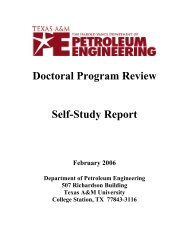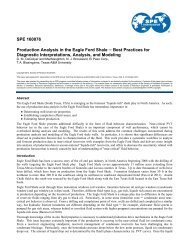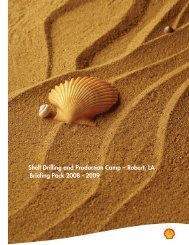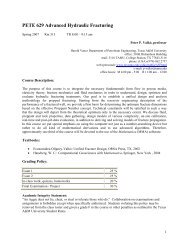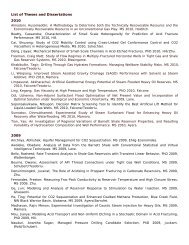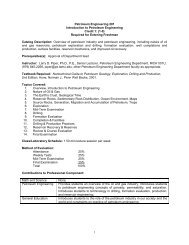Crisman Annual Report 2009 - Harold Vance Department of ...
Crisman Annual Report 2009 - Harold Vance Department of ...
Crisman Annual Report 2009 - Harold Vance Department of ...
You also want an ePaper? Increase the reach of your titles
YUMPU automatically turns print PDFs into web optimized ePapers that Google loves.
Combustion Assisted Gravity Drainage (CAGD): An In-Situ Combustion Method<br />
to Recover Heavy Oil and Bitumen from Geologic Formations using a Horizontal<br />
Injector-Producer Pair<br />
Objectives<br />
In-situ combustion (ISC) is a recovery process<br />
particularly suitable for heavy oil reservoirs at<br />
depths greater than 3500 ft when steam injection<br />
is not feasible due to severe wellbore heat losses.<br />
We have developed a method in which a horizontal<br />
air injector is placed above a horizontal producer<br />
(Fig. 1). In this Combustion Assisted Gravity<br />
Drainage (CAGD) method, a heated chamber is<br />
created that would more uniformly transfer heat<br />
from the combustion front. Mobilized oil is produced<br />
by gravity drainage to the lower horizontal well.<br />
Gravity segregation enhances air flow to propagate<br />
the combustion front. Main research objectives are<br />
as follows:<br />
» Assess CAGD using Computer Modelling Group<br />
(CMG) simulator<br />
» Conduct experiments using a scaled 3D physical<br />
model to test viability <strong>of</strong> CAGD for heavy oil and<br />
Cold Lake bitumen<br />
» Compare CAGD and toe-to-heel air injection<br />
(THAI) processes<br />
» Using CMG simulator, history-match laboratory<br />
CAGD results and scale up to field conditions<br />
experimental results and scale up to field conditions<br />
and evaluate CAGD.<br />
Accomplishments<br />
A 50 cm x 15 cm x 35 cm Cartesian simulation<br />
model was constructed representing the half<br />
symmetry element <strong>of</strong> a 750 m long x 56 m width x<br />
35 m thick drainage volume; we placed the injector<br />
at 7 m above the reservoir base with a producer<br />
5 m below the injector. The model was based on<br />
typical Athabasca oil and rock properties. Runs<br />
were made to compare CAGD with steam assisted<br />
gravity drainage (SAGD) and THAI. Results indicate<br />
CAGD to have the highest oil production with the<br />
lowest energy consumption (Figs. 2 and 3).<br />
The physical model, measuring 60 cm x 40 cm x 15<br />
cm, is nearly completed (Fig. 4). The steel sides<br />
will be lined with ceramic fiber insulation. Seventy<br />
two thermocouples will measure temperature in the<br />
sandmix with an operating pressure at about 30<br />
psig.<br />
CRISMAN INSTITUTE<br />
Fig. 1. Schematic illustration <strong>of</strong> CAGD.<br />
Approach<br />
We will conduct a simulation using CMG for a<br />
preliminary evaluation <strong>of</strong> CAGD. If simulation<br />
results show CAGD to be promising, we will conduct<br />
experimental runs using a physical model to evaluate<br />
performance <strong>of</strong> CAGD. We will also history match<br />
40<br />
Project Information<br />
1.3.24 Combustion Assisted Gravity Drainage (CAGD):<br />
An In-Situ Combustion Method to Recover Heavy Oil and<br />
Bitumen from Geologic Formations using a Horizontal<br />
Injector-Producer Pair<br />
Related Publications<br />
Greaves, M., Xia, T.X. and Turta, A.T. Stability <strong>of</strong> THAI<br />
Process-Theoretical and Experimental Observations. Paper<br />
presented at the 2007 Canadian International Petroleum<br />
Conference, Calgary, Alberta, 12-14 June.<br />
Contacts<br />
Daulat Mamora<br />
979.845.2962<br />
daulat.mamora@pe.tamu.edu<br />
Hamid Rahnema<br />
<strong>Crisman</strong> <strong>Annual</strong> <strong>Report</strong> <strong>2009</strong>



